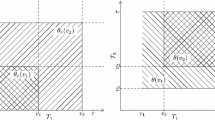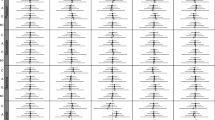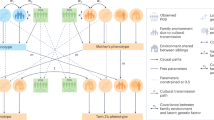Abstract
Twin and family data provide a key source for evaluating inheritance of specific diseases. A standard analysis of such data typically involves the computation of prevalences and different concordance measures such as the casewise concordance, that is the probability that one twin has the disease given that the co-twin has the disease. Most diseases have a varying age-of-onset that will lead to age-specific prevalence. Typically, this aspect is not considered, and this may lead to severe bias as well as make it very unclear exactly what population quantities that we are estimating. In addition, one will typically need to deal with censoring in the data, that is the fact that we for some subjects only know that they are alive at a specific age without having the disease. These subjects needs to be considered age specifically, and clearly if they are young there is still a risk that they will develop the disease. The aim of this contribution is to show that the standard casewise concordance and standard prevalence estimators do not work in general for age-of-onset data. We show how one can in fact do something easy and simple even with censored data. The key is to take age into account when analysing such data.




Similar content being viewed by others
References
Chen BE, Kramer JL, Greene MH, Rosenberg PS (2008) Competing risks analysis of correlated failure time data. Biometrics 64:172–79
Cheng Y, Fine JP, Kosorok MR (2007) Nonparametric association analysis of bivariate competing-risks data. J Am Stat Assoc 102:1407–1415
Eriksson F, Scheike T (2015) Additive gamma frailty models with applications to competing risks in related individuals. Biometrics doi:10.1111/biom.12326
Gorfine M, Hsu L (2011) Frailty-based competing risks model for multivariate survival data. Biometrics 67:415–426
Hannah MC, Hopper JL, Mathews JD (1983) Twin concordance for a binary trait. I. Statistical models illustrated with data on drinking status. Acta Genet Med Gemellol 32(2):127–137
Hannah MC, Hopper JL, Mathews JD (1985) Twin concordance for a binary trait. II. Nested analysis of ever-smoking and ex-smoking traits and unnested analysis of a “committed-smoking” trait. Am J Human Genet 37(1):153
Hjelmborg J, Scheike T, Holst K, Skytthe A, Christensen K, Adami H-O, Czene K, Harris JR, Kaprio J, Mucci L et al (2014) The heritability of prostate cancer in the Nordic Twin Study of Cancer. Cancer Epidemiol Biomarkers Prev 23(11):2303–2310. doi:10.1158/1055-9965
Holst KK, Scheike T (2014) Mets: analysis of multivariate event times. R package version 0.2.8.1
Holst KK, Scheike TH, Hjelmborg JB (2015) The liability threshold model for censored twin data. Comput Stat and Data Anal doi:10.1016/j.csda.2015.01.014
Hopper JL, Hannah MC, Macaskill GT, Mathews JD, Rao D (1990) Twin concordance for a binary trait: III. A bivariate analysis of hay fever and asthma. Genet Epidemiol 7(4):277–289
Kalbfleisch JD, Prentice RL (1980) The statistical analysis of failure time data. Wiley, New York
Scheike TH, Holst K, Hjelmborg JV (2014) Estimating heritability for cause specific mortality based on twin studies. Lifetime Data Anal 20:210–233
Scheike TH, Sun Y, Zhang MJ, Jensen TK (2010) A semiparametric random effects model for multivariate competing risks data. Biometrika 97:133–145
Smith C (1974) Concordance in twins: methods and interpretation. Am J Human Genet 26(4):454
Thomas DC et al (2004) Statistical methods in genetic epidemiology. Oxford University Press, Oxford
Thomas DC, Langholz B, Mack W, Floderus B, Rao D, Vogler G (1990) Bivariate survival models for analysis of genetic and environmental effects in twins. Genet Epidemiol 7(2):121–135
Witte J, Carlin J, Hopper J (1999) Likelihood-based approach to estimating twin concordance for dichotomous traits. Genet Epidemiol 16(3):290–304
Acknowledgments
We are truly grateful to two referees and the editor for their careful reading of our manuscript and their very useful suggestions.
Conflict of Interest
Thomas H. Scheike, Jacob B. Hjelmborg and Klaus K. Holst declare that they have no conflict of interest.
Human and Animal Rights and Informed Consent
The paper only works on data collected by Danish twin registry that complies with the rules of Human and Animal rights.
Author information
Authors and Affiliations
Corresponding author
Additional information
Edited by Gitta Lubke.
Rights and permissions
About this article
Cite this article
Scheike, T.H., Hjelmborg, J.B. & Holst, K.K. Estimating Twin Pair Concordance for Age of Onset. Behav Genet 45, 573–580 (2015). https://doi.org/10.1007/s10519-015-9729-3
Received:
Accepted:
Published:
Issue Date:
DOI: https://doi.org/10.1007/s10519-015-9729-3




